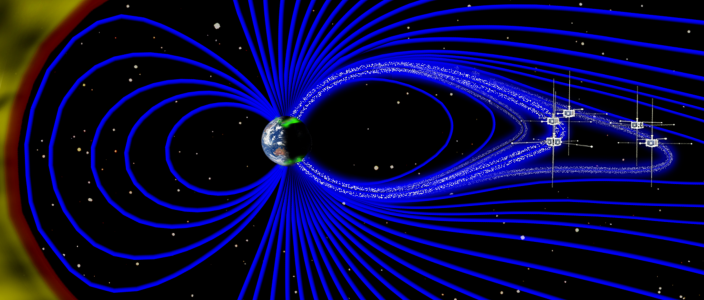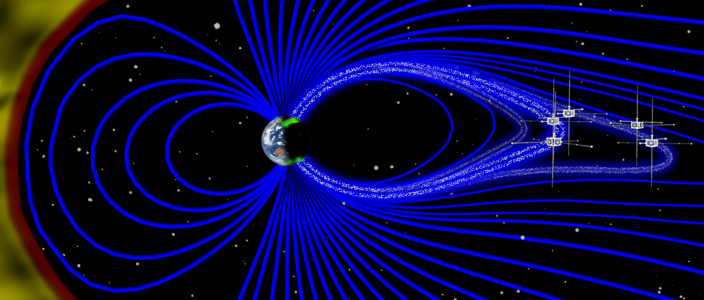Image caption: An artist’s rendering of the magnetosphere in cross-section, with the sun and solar wind on the left and magnetic field lines emanating from the Earth in blue. The five THEMIS probes were well-positioned to directly observe one particular magnetic field line as it moved back and forth every six minutes. This magnetic field motion caused electrons (white dots) to stream along the field line and enter Earth’s north and south poles, brightening a specific region of the aurora. Credit: E. Masongsong, UCLA EPSS, NASA EYES.
Auroras Dance to the Pulse of Earth’s Magnetic Field
by Emmanuel Masongsong, UCLA EPSS/IGPP/iPLEX
The majestic aurora has captivated humans for millennia, yet the mysterious lights’ electromagnetic nature and connection to solar activity were only realized in the last 150 years. Detailed study of the aurora has finally become possible in recent decades with coordinated multi-satellite observations, and worldwide networks of ground-based magnetic sensors and cameras. Using data from NASA’s THEMIS mission, an international team of scientists observed Earth’s vibrating magnetic field at an altitude of 40,000 miles, more than 5 times the Earth’s diameter, while simultaneously capturing the northern lights dancing in the night sky over Canada. Their findings, reported in the journal Nature Physics, are the first to directly map the back-and- forth motion of this distant magnetic field and the resulting electrical currents to a particular region of brightening aurora in Earth’s upper atmosphere. This is an important link in understanding and eventually predicting how solar activity and space electricity can impact our technological infrastructure.
The Earth is connected to the sun via the solar wind, an outward flow of electromagnetic radiation and charged particles (plasma) that affects all the planets, moons, comets, and asteroids in our solar system. These interactions, collectively known as space weather, include solar flares and violent plasma eruptions that could jam radio signals, damage weather, communications and GPS satellites, or even disable our global electrical power grid. Luckily for us, Earth has a spinning, molten metal core that generates a magnetic force field known as the magnetosphere. Magnetic field lines, like immense loops that extend outward from the Earth’s north and south poles, form a giant protective bubble that shields us from most harmful space weather.
Under the right conditions, however, some solar wind particles and energy can enter the magnetosphere and subsequently be released in powerful bursts that can power the auroras, called a substorm. The magnetic field lines surrounding our planet vibrate wildly and mobilize the surrounding plasma, causing electrons to stream along the magnetic field lines until they fall into Earth's poles. The electrons collide with atmospheric oxygen and nitrogen atoms, which then emit the familiar green and red/blue colors of the aurora. This process is like a cosmic electric guitar string, whose motion is converted to an electrical current that flows into a distant amplified speaker, but instead of a note it results in an epic plasma light show!
In 2007 NASA launched THEMIS’s five satellites to make coordinated measurements of space plasmas and ground auroras, in order to understand this energy release. In the study reported in Nature Physics, the space and ground assets were particularly well-positioned to capture the motion of the oscillating magnetic field lines together with the aurora they produced. The oscillation frequency was a mere one cycle every six minutes, yet the field line stretched back and forth by as much as two Earth diameters and the power produced, about 10GW, dwarfed the generating capacity of the largest nuclear power plants. Ground-based magnetic sensors across Canada and Greenland recorded the inflowing electrical currents, while specialized all-sky cameras captured the aurora as it brightened and dimmed, appearing to dance in lock-step with the six minute period of the vibrating magnetic field line. To verify this correlation, the researchers compared the electromagnetic energy released deep in the magnetosphere with the amount dissipated in the Earth’s upper atmosphere. “We were delighted to see such a strong match,” said Evgeny Panov, lead author and researcher at the Space Research Institute, of the Austrian Academy of Sciences in Graz. “These observations reveal the missing link in the conversion of magnetic energy to particle energy that powers the aurora.”
The most intense geomagnetic storm on record occurred in 1859 when space weather phenomena affected few people, whereas today a broad range of industries and infrastructure would be crippled by such a space storm. With the continued growth of the commercial space industry, space tourism, and increasing dependence on GPS positioning for automated cars and aircraft, accurate space weather forecasting and alerts are becoming ever more crucial. THEMIS is a key component of this research fleet, refining our ability to make higher-fidelity space weather models. “Even after nearly ten years, the probes are still in great health, and our growing network of magnetometers and all-sky cameras continue to generate high quality data,” said Vassilis Angelopoulos, co-author and THEMIS principal investigator at UCLA.
THEMIS is part of NASA’s Explorer program, managed by the Goddard Space Flight Center. UC Berkeley’s Space Sciences Laboratory is responsible for mission operations and built several of the on-board and ground-based instruments. Austria, Canada, France and Germany contributed instrumentation, operations and science. ATK (formerly Swales Aerospace), built the THEMIS spacecraft. The all-sky imagers and magnetometers are jointly operated by UC Berkeley, UCLA, University of Calgary, and University of Alberta, Canada.
Follow Iplex

